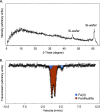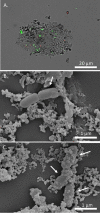Nitrate Removal by a Novel Lithoautotrophic Nitrate-Reducing, Iron(II)-Oxidizing Culture Enriched from a Pyrite-Rich Limestone Aquifer
- PMID: 34085863
- PMCID: PMC8373248
- DOI: 10.1128/AEM.00460-21
Nitrate Removal by a Novel Lithoautotrophic Nitrate-Reducing, Iron(II)-Oxidizing Culture Enriched from a Pyrite-Rich Limestone Aquifer
Abstract
Nitrate removal in oligotrophic environments is often limited by the availability of suitable organic electron donors. Chemolithoautotrophic bacteria may play a key role in denitrification in aquifers depleted in organic carbon. Under anoxic and circumneutral pH conditions, iron(II) was hypothesized to serve as an electron donor for microbially mediated nitrate reduction by Fe(II)-oxidizing (NRFeOx) microorganisms. However, lithoautotrophic NRFeOx cultures have never been enriched from any aquifer, and as such, there are no model cultures available to study the physiology and geochemistry of this potentially environmentally relevant process. Using iron(II) as an electron donor, we enriched a lithoautotrophic NRFeOx culture from nitrate-containing groundwater of a pyrite-rich limestone aquifer. In the enriched NRFeOx culture that does not require additional organic cosubstrates for growth, within 7 to 11 days, 0.3 to 0.5 mM nitrate was reduced and 1.3 to 2 mM iron(II) was oxidized, leading to a stoichiometric NO3-/Fe(II) ratio of 0.2, with N2 and N2O identified as the main nitrate reduction products. Short-range ordered Fe(III) (oxyhydr)oxides were the product of iron(II) oxidation. Microorganisms were observed to be closely associated with formed minerals, but only few cells were encrusted, suggesting that most of the bacteria were able to avoid mineral precipitation at their surface. Analysis of the microbial community by long-read 16S rRNA gene sequencing revealed that the culture is dominated by members of the Gallionellaceae family that are known as autotrophic, neutrophilic, and microaerophilic iron(II) oxidizers. In summary, our study suggests that NRFeOx mediated by lithoautotrophic bacteria can lead to nitrate removal in anthropogenically affected aquifers. IMPORTANCE Removal of nitrate by microbial denitrification in groundwater is often limited by low concentrations of organic carbon. In these carbon-poor ecosystems, nitrate-reducing bacteria that can use inorganic compounds such as Fe(II) (NRFeOx) as electron donors could play a major role in nitrate removal. However, no lithoautotrophic NRFeOx culture has been successfully isolated or enriched from this type of environment, and as such, there are no model cultures available to study the rate-limiting factors of this potentially important process. Here, we present the physiology and microbial community composition of a novel lithoautotrophic NRFeOx culture enriched from a fractured aquifer in southern Germany. The culture is dominated by a putative Fe(II) oxidizer affiliated with the Gallionellaceae family and performs nitrate reduction coupled to Fe(II) oxidation leading to N2O and N2 formation without the addition of organic substrates. Our analyses demonstrate that lithoautotrophic NRFeOx can potentially lead to nitrate removal in nitrate-contaminated aquifers.
Keywords: NRFeOx; aquifer; geomicrobiology; groundwater; iron metabolism; iron oxidizers; nitrate; pyrite.
Figures




Similar articles
-
Nitrous oxide is the main product during nitrate reduction by a novel lithoautotrophic iron(II)-oxidizing culture from an organic-rich paddy soil.Appl Environ Microbiol. 2025 Jan 31;91(1):e0126224. doi: 10.1128/aem.01262-24. Epub 2024 Dec 6. Appl Environ Microbiol. 2025. PMID: 39641603 Free PMC article.
-
Presence of Fe(II) and nitrate shapes aquifer-originating communities leading to an autotrophic enrichment dominated by an Fe(II)-oxidizing Gallionellaceae sp.FEMS Microbiol Ecol. 2021 Nov 13;97(11):fiab145. doi: 10.1093/femsec/fiab145. FEMS Microbiol Ecol. 2021. PMID: 34724047
-
Metabolic Performance and Fate of Electrons during Nitrate-Reducing Fe(II) Oxidation by the Autotrophic Enrichment Culture KS Grown at Different Initial Fe/N Ratios.Appl Environ Microbiol. 2023 Mar 29;89(3):e0019623. doi: 10.1128/aem.00196-23. Epub 2023 Mar 6. Appl Environ Microbiol. 2023. PMID: 36877057 Free PMC article.
-
Microbially mediated coupling of nitrate reduction and Fe(II) oxidation under anoxic conditions.FEMS Microbiol Ecol. 2019 Apr 1;95(4):fiz030. doi: 10.1093/femsec/fiz030. FEMS Microbiol Ecol. 2019. PMID: 30844067 Review.
-
Iron sulphides mediated autotrophic denitrification: An emerging bioprocess for nitrate pollution mitigation and sustainable wastewater treatment.Water Res. 2020 Jul 15;179:115914. doi: 10.1016/j.watres.2020.115914. Epub 2020 May 6. Water Res. 2020. PMID: 32413614 Review.
Cited by
-
Arsenic immobilization and greenhouse gas emission depend on quantity and frequency of nitrogen fertilization in paddy soil.Heliyon. 2024 Aug 3;10(16):e35706. doi: 10.1016/j.heliyon.2024.e35706. eCollection 2024 Aug 30. Heliyon. 2024. PMID: 39247294 Free PMC article.
-
Primary succession of microbial communities in an aquifer from the Covey Hill formation in Quebec, Canada.Front Microbiol. 2025 May 21;16:1568469. doi: 10.3389/fmicb.2025.1568469. eCollection 2025. Front Microbiol. 2025. PMID: 40469743 Free PMC article.
-
Gallionellaceae pangenomic analysis reveals insight into phylogeny, metabolic flexibility, and iron oxidation mechanisms.mSystems. 2023 Dec 21;8(6):e0003823. doi: 10.1128/msystems.00038-23. Epub 2023 Oct 26. mSystems. 2023. PMID: 37882557 Free PMC article.
-
Anaerobic ammonium oxidation coupled to iron(III) reduction catalyzed by a lithoautotrophic nitrate-reducing iron(II) oxidizing enrichment culture.ISME J. 2024 Jan 8;18(1):wrae149. doi: 10.1093/ismejo/wrae149. ISME J. 2024. PMID: 39083023 Free PMC article.
-
Depth wide distribution and metabolic potential of chemolithoautotrophic microorganisms reactivated from deep continental granitic crust underneath the Deccan Traps at Koyna, India.Front Microbiol. 2022 Nov 24;13:1018940. doi: 10.3389/fmicb.2022.1018940. eCollection 2022. Front Microbiol. 2022. PMID: 36504802 Free PMC article.
References
Publication types
MeSH terms
Substances
LinkOut - more resources
Full Text Sources

